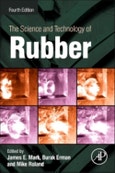The 4e of The Science and Technology of Rubber provides a broad survey of elastomers with special emphasis on materials with a rubber-like elasticity. As in previous editions, the emphasis remains on a unified treatment of the material, exploring chemical aspects such as elastomer synthesis and curing, through recent theoretical developments and characterization of equilibrium and dynamic properties, to the final applications of rubber, including tire engineering and manufacturing. Updated material stresses the continuous relationship between ongoing research in synthesis, physics, structure and mechanics of rubber technology and industrial applications. Special attention is paid to recent advances in rubber-like elasticity theory and new processing techniques for elastomers. Exciting new developments in green tire manufacturing and tire recycling are covered.
Please Note: This is an On Demand product, delivery may take up to 11 working days after payment has been received.
Table of Contents
1. Rubber Elasticity: Basic Concepts and Behavior
2. Polymerization: Elastomer Synthesis
3. Structure Characterization in the Science and Technology of Elastomers
4. The Molecular Basis of Rubberlike Elasticity
5. The Viscoelastic Behavior of Rubber
6. Rheological Behavior and Processing of Unvulcanized Rubber
7. Vulcanization
8. Reinforcement of Elastomers by Particulate Fillers
9. The Science of Rubber Compounding
10. Strength of Elastomers
11. The Chemical Modification of Polymers
12. Elastomer Blends
13. Thermoplastic Elastomers
14. Bioelastomers
15. Tire Engineering
16. Recycling of Rubbers
Index








